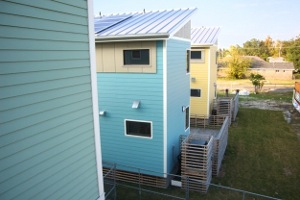 The soft color palette helps to blend the European design of Global Green USA's three homes in New Orleans' historic Holy Cross neighborhood bordering the Mississippi River. Project plans call the construction of two more single-family homes, a 17-unit multi-family apartment building and a community center with public-use space, a grocery store, and bank branch. Photo credit: Roger Hahn.
The soft color palette helps to blend the European design of Global Green USA's three homes in New Orleans' historic Holy Cross neighborhood bordering the Mississippi River. Project plans call the construction of two more single-family homes, a 17-unit multi-family apartment building and a community center with public-use space, a grocery store, and bank branch. Photo credit: Roger Hahn.
Home Energy Magazine’s man in New Orleans, Roger Hahn, a freelance journalist, feels like he is living in a Petri dish of building-science-based, affordable, efficient, healthy, and ecologically integrated home building and renovation in the new, New Orleans. "Historians will one day come to view the post-Katrina rebuilding of New Orleans and the Gulf Coast as the first major example of green design and technologies playing a major role in the reconstruction of vulnerable, disaster-prone communities," says Hahn.
Money from the federal disaster relief funds has been slow in coming to the people in New Orleans who need it. "The money often winds up being not enough money to elevate above newly mandated flood levels and rebuild something similar to what was damaged in the flood at the same time," says Hahn. It is nonprofits such as Global Green, Habitat for Humanity, Enterprise Community Partners, the Jericho Road Episcopal Housing Initiative, and actor Brad Pitt’s futuristic new homes program Make It Right that are on the ground building and renovating whole neighborhoods such as the Lower Ninth Ward and the Holy Cross neighborhood, both devastated by Katrina and her aftermath.
Did you know that New Orleans was the center of a Silicon Valley-like tech boom in the early 1800s and again in the early 1900s? Early on, the city nurtured inventors and inventions such as the steam engine, the cotton gin, and methods of refining sugar cane. Later, a New Orleans engineer invented a water pump powerful enough to drain marshlands. We have recent memories of the Superdome in New Orleans as a place where people were warehoused after the storm and floods destroyed their homes, with dead bodies covered in sheets on the sidewalks out front, and people begging for food and water in front of the TV cameras. But the Superdome was built as the largest fixed-dome structure in the world.
Hahn has lived in the city for more than 15 years, and was a frequent visitor before that. After going through the citywide depression that fell on the city after the disaster, he’s ready with his adopted city for the Phoenix to rise from the wet ashes. "It’s possible to imagine New Orleans emerging as a leader in three related areas: coastal flood management; advanced construction techniques that address storm- and flood-prone communities; and as a central hub in a growing worldwide network of manufacturers, developers, and architects pushing for residential and commercial solutions emphasizing affordability as a central element in energy-efficient design and construction," says Hahn.
